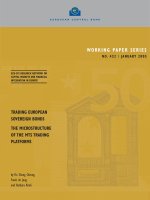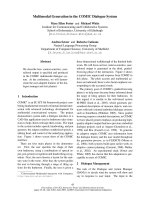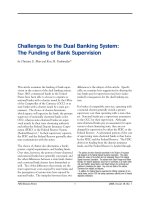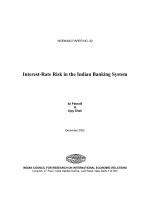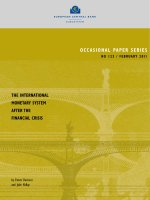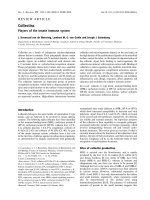The internetional monetary system docx
Bạn đang xem bản rút gọn của tài liệu. Xem và tải ngay bản đầy đủ của tài liệu tại đây (81.65 KB, 11 trang )
CHAPTER 2
THE INTERNATIONAL MONETARY
SYSTEM
Chapter Objectives:
1. Evolution of the International Monetary
System
2. International institutions systems
3. International financial adjustment
Chapter Objectives:
1. Evolution of the International Monetary
System
2. International institutions systems
3. International financial adjustment
12/19/2010 1
B02013 - The international Monetary
system
1. Evolution of the International Monetary
System
• Bimetallism: Before 1875
• Classical Gold Standard: 1875-1914
• Interwar Period: 1915-1944
• Bretton Woods System: 1945-1972
• The Flexible Exchange Rate Regime: 1973-
Present
• Bimetallism: Before 1875
• Classical Gold Standard: 1875-1914
• Interwar Period: 1915-1944
• Bretton Woods System: 1945-1972
• The Flexible Exchange Rate Regime: 1973-
Present
12/19/2010 2
B02013 - The international Monetary
system
1.1. Bimetallism: Before 1875
• A “double standard” in the sense that both gold
and silver were used as money.
• Both gold and silver were used as international
means of payment and the exchange rates
among currencies were determined by either
their gold or silver contents.
• A “double standard” in the sense that both gold
and silver were used as money.
• Both gold and silver were used as international
means of payment and the exchange rates
among currencies were determined by either
their gold or silver contents.
12/19/2010 3
B02013 - The international Monetary
system
1.2. Classical Gold Standard: 1875-1914
• During this period in most major countries.
• The exchange rate between two country’s
currencies would be determined by their relative
gold contents.
• During this period in most major countries.
• The exchange rate between two country’s
currencies would be determined by their relative
gold contents.
12/19/2010 4
B02013 - The international Monetary
system
1.3. Interwar Period: 1915-1944
• Exchange rates fluctuated as countries widely
used “predatory” depreciations of their
currencies as a means of gaining advantage in
the world export market.
12/19/2010 5
B02013 - The international Monetary
system
1.4. The Bretton Woods system
• Under the Bretton Woods system, the U.S. dollar
was pegged to gold at $35 per ounce and other
currencies were pegged to the U.S. dollar.
• The Bretton Woods system was a dollar-based
gold exchange standard.
• Under the Bretton Woods system, the U.S. dollar
was pegged to gold at $35 per ounce and other
currencies were pegged to the U.S. dollar.
• The Bretton Woods system was a dollar-based
gold exchange standard.
12/19/2010 6
B02013 - The international Monetary
system
1.5.The Flexible Exchange Rate Regime:
1973-Present
• Flexible exchange rates were declared
acceptable to the IMF members.
• Gold was abandoned as an international
reserve asset.
• Flexible exchange rates were declared
acceptable to the IMF members.
• Gold was abandoned as an international
reserve asset.
12/19/2010 7
B02013 - The international Monetary
system
2. International institutions systems
2.1.The financial institutions:
• Stock market
• All funds: superannuation, Mutual Funds…
• Banks
• Financial institutions of government.
2.1.The financial institutions:
• Stock market
• All funds: superannuation, Mutual Funds…
• Banks
• Financial institutions of government.
12/19/2010 8
B02013 - The international Monetary
system
2.2. International institutions:
- Eurocurrency market
- Bank for international settlements
- World Bank
- International Finance Corporation
- International Development Association (IDA)
- International Monetary Fund (IMF)
- Asian Development Bank
2.2. International institutions:
- Eurocurrency market
- Bank for international settlements
- World Bank
- International Finance Corporation
- International Development Association (IDA)
- International Monetary Fund (IMF)
- Asian Development Bank
12/19/2010 9
B02013 - The international Monetary
system
3. International financial adjustment
3.1. Structural Adjustment Facilities.
3.2. The Basel Committee on Banking
Supervision
3.3. International banking facilities (IBF)
3.4. IMF conditionality
3.1. Structural Adjustment Facilities.
3.2. The Basel Committee on Banking
Supervision
3.3. International banking facilities (IBF)
3.4. IMF conditionality
12/19/2010 10
B02013 - The international Monetary
system
Mini-Case Questions: The Revaluation of
the Chinese Yuan
• Many Chinese critics had urged China to revalue
the yuan by 20% or more. What would the
Chinese yuan’s value be in US dollars if it had
indeed been devalued by 20%?
• Do you believe that the revaluation of the
Chinese yean was politically or economically
motivated?
• Many Chinese critics had urged China to revalue
the yuan by 20% or more. What would the
Chinese yuan’s value be in US dollars if it had
indeed been devalued by 20%?
• Do you believe that the revaluation of the
Chinese yean was politically or economically
motivated?
12/19/2010 11
B02013 - The international Monetary
system



